Best Tire Pressure For Mountain Bike (2024 Update)
Riding a mountain bike on under-inflated tires is a surefire way to ruin your day. With the wrong pressure, you’ll face higher rolling resistance, sluggish handling, and an increased risk of pinch flats. But what’s the optimal tire pressure for mountain biking? It depends on several factors.
First, consider the width of your tires. Wider tires typically run at lower pressures for better traction and comfort. Narrower tires need higher pressure to prevent pinch flats on rocky terrain. Second, factor in your weight. Heavier riders require more air volume to prevent the tire casing from bottoming out over bumps. Lighter riders can drop the pressure for extra grip and cushioning.
Finally, think about the trail conditions. Loose surfaces like sand call for lower pressures to maximize surface contact. Hard-packed singletrack and pavement allow you to add more air for less rolling resistance. Are there lots of sharp rocks that could snakebite your tires? Bump up the pressure a bit.
Finding the sweet spot takes some experimentation. Start in the middle of the tire’s recommended range, then fine-tune from there. Too many flats or squirmy handling? Add a few more PSI. Feel like you’re bouncing around without control? Let out some air. Dialing in the ideal pressure will have you rolling fast and confident on every mountain bike adventure.
10 Best Tire Pressure For Mountain Bike
| # | Product Image | Product Name | Product Notes | Check Price |
|---|---|---|---|---|
|
1
|
Checking tire pressure for road bikes and BMXs with both Presta and Schrader valves.
|
|
||
|
2
|
Ideal for measuring tire pressure on mountain bikes and other vehicles with Presta or Schrader valves.
|
|
||
|
3
|
The product is ideal for measuring the air pressure in mountain bike tires, aiding in cycling repair and maintenance.
|
|
||
|
4
|
The product is ideal for measuring and maintaining the air pressure of bicycle tires, both for road and mountain bikes.
|
|
||
|
5
|
Measuring bike tire pressure with a bleeder valve and ANSI certification.
|
|
||
|
6
|
The product is ideal for inflating bicycle tires with both Presta and Schrader valve types using an air compressor.
|
|
||
|
7
|
The product is ideal for measuring tire pressure on cars, trucks, and bicycles with its backlight LCD and non-skid grip.
|
|
||
|
8
|
The product is ideal for measuring tire pressure on bicycles and other vehicles with Presta valves.
|
|
||
|
9
|
This product is ideal for measuring air pressure in bicycle tires.
|
|
||
|
10
|
Ideal for measuring low pressure in bicycle tires with a Presta valve.
|
|
1. Bikepro Pressure Gauge For Perfect Tire Inflation
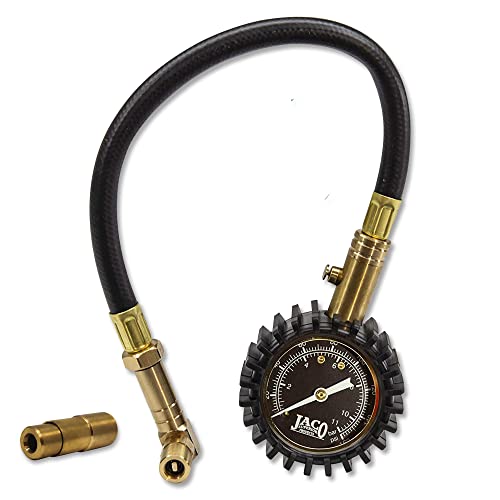
JACO gauges have earned the trust of cyclists for their accurate and reliable performance. These gauges are calibrated to ANSI Standards (±1.5%) at a NIST certified testing facility, ensuring precise pressure readings without relying on batteries. These gauges are designed to work with road bikes, cars, trucks, and SUVs.
The gauge features a larger, 2 inch glow-in-the-dark dial that is easy to read. It has a dual measurement scale of 0-160 PSI / 0-11 BAR, providing accurate readings that "lock" in place until the pressure reset button on the brass neck is pressed. This feature ensures that the user can take an accurate reading without having to hold the gauge in place.
The robust and versatile design of the JACO gauge is equipped with interchangeable air chucks to fit both bicycle Presta and/or Schrader valve stems. It also features a built-in air bleeder valve to reduce pressure in overinflated tires. This feature ensures that the user can easily adjust the pressure of their tires to the desired level.
The gauge feels sturdy in the hand and is built from solid brass shielded by a rugged gear-style protective shock guard. Additionally, it features a flexible leak-proof hybrid air hose that can easily get in between the spokes. These features make it a durable and reliable tool for any cyclist.
The JACO gauge is a must-have tool for any bike tire repair kit. It ensures better performance on the road or trail and improved traction with properly inflated bicycle tires. With its accurate readings and versatile design, the JACO gauge is an essential tool for any cyclist.
2. Jaco Bikepro Bike Tire Pressure Gauge – 60 Psi (Mtb Series) | Presta + Schrader Air Chucks
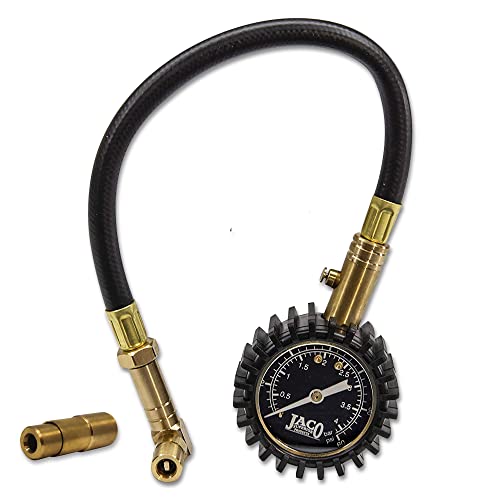
Looking for a reliable and accurate tire pressure gauge that can handle all of your outdoor adventures? Look no further than this performance-tested gauge, which is calibrated to a precise ±1.5% accuracy with ANSI certification at an industrial facility to ensure accurate pressure readings without relying on batteries.
Designed for use with mountain bikes, cars, trucks, and SUVs, this gauge features a larger, 2-inch glow-in-the-dark dial that is easy to read, even in low-light conditions. The dual measurement scale provides accurate readings in both PSI and BAR, and the readings "lock" in place until the pressure reset button on the brass neck is pressed.
The gauge's robust and versatile design is equipped with interchangeable air chucks to fit both bicycle Presta and Schrader valve stems, and it features a built-in air bleeder valve to reduce pressure in overinflated tires. The gauge feels sturdy in the hand and is built from solid brass shielded by a rugged gear-style protective shock guard. It also features a flexible, no-leak air hose to easily get in between the spokes.
With its lifetime warranty, you can ride with confidence and enjoy better performance and traction with properly inflated tires. So whether you're hitting the trails or cruising around town, this tire pressure gauge is the perfect tool for keeping your tires in top condition.
3. Vbestlife Bike Tire Pressure Gauge – Precise Readings
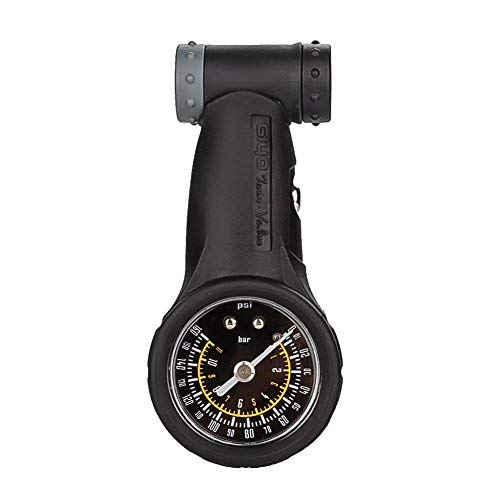
Introducing the DUALVALVE Tire Pressure Gauge, a must-have tool for every bike owner. This gauge is suitable for both Presta and Schrader type valve without the need for an adapter, making it a versatile tool for any cyclist.
One of the key features of this tire pressure gauge is its integrated hold design, which ensures accurate pressure reading every time you use it. By maintaining correct tire pressure, you can reduce tire wear and extend tire life, ultimately saving you money in the long run.
The measurement range of this gauge is 0-160psi, and it displays pressure in both PSI and Bar (up to 11 Bar). This makes it suitable for not only bike tires but also motorcycle and auto car tires. With its instant pressure reading feature, you can quickly and easily check your tire pressure on the go.
The pressure lock system is another helpful feature of this gauge. It instantly captures the tire pressure, which remains on the display until the pressure is released from the gauge, even when the gauge is removed from the tire. This makes it easier to read and record your tire pressure accurately.
Made of quality plastic, this tire pressure gauge is sturdy, wearable, and durable. It is also lightweight and portable, making it easy to carry around with you wherever you go. You can mount it on your bike or put it in your bike bag for easy access.
4. Digital Bike Tire Gauge – Accurately Measure Pressure!
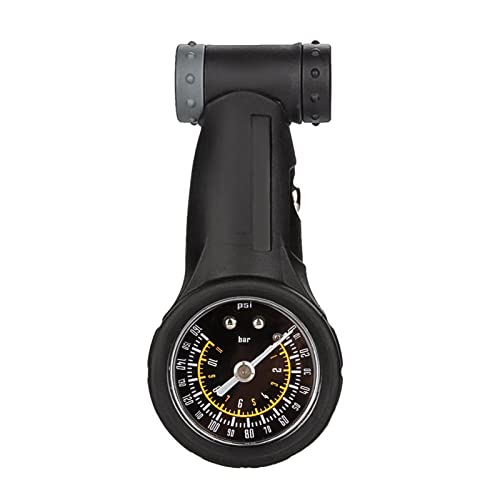
This high-quality bike gauge is made of sturdy and durable plastic, ensuring its wearability and long-lasting use. Its wide application makes it suitable for both Presta and Schrader type valves, and its measurement range of 0-160psi makes it perfect for most bikes. As a useful tool for bike owners, it helps save time and money by eliminating the need for expensive and complicated devices for pressure measurement. With just a few seconds of use, this gauge provides a precise and accurate pressure reading every time, allowing you to verify and go.
Designed with an integrated hold feature, this bicycle gauge helps maintain correct tire pressure, reducing tire wear and extending tire life. The gauge is easy to use and provides a quick, reliable pressure reading that is essential for maintaining optimal bike performance.
With a commitment to customer satisfaction, the manufacturer offers a guarantee that if you are not satisfied with the product, you can send an email at any time and receive an instant reply to help solve your problem.
5. Milton Accu-Gage: Precision Pressure Gauge For Bikes
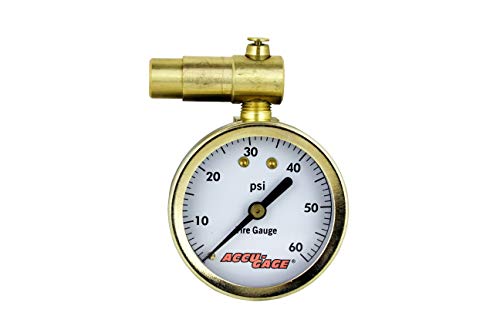
This tire pressure gauge is the ultimate tool for heavy-duty use. Unlike piston-plunger-type gauges, this gauge is designed to withstand changes in temperature, humidity, altitude, and air stream contaminants. With no batteries required, this analog tire tool is flexible enough to fit all your terrain, temperature, and long-ride needs.
Fitted with a Presta Valve stem and Air Chuck, this tire pressure gauge provides a seamless connection seal with no air leakage. This feature gives you precise and accurate control whether you're checking the tire pressure or bleeding excess air. The gauge is calibrated to ANSI Commercial Grade B gauges and meets ANSI B40.1 Grade B specifications. This calibration ensures a rapid and accurate reading, making it the perfect, easy-to-use gauge for hard-to-reach tires.
The mechanical gauge design retains the PSI reading after removing it from the tire. This function makes it easy to check multiple tires without having to write down the readings. The dual function of this tire pressure gauge provides quick, accurate readings and is also equipped with a deflator valve. This feature helps release extra air from your tires for precise tire pressure adjustment.
Maintaining proper tire pressures improves bicycle handling and reduces the risk of tire failure across terrains. This product is a safety investment that extends the life of your tires. Reduce wear and tear with a heavy-duty, all-purpose tire tool that lasts. Keep yourself safe while riding for years to come with this durable tire pressure gauge.
6. Auto-Select Bike Inflator With Digital Gauge
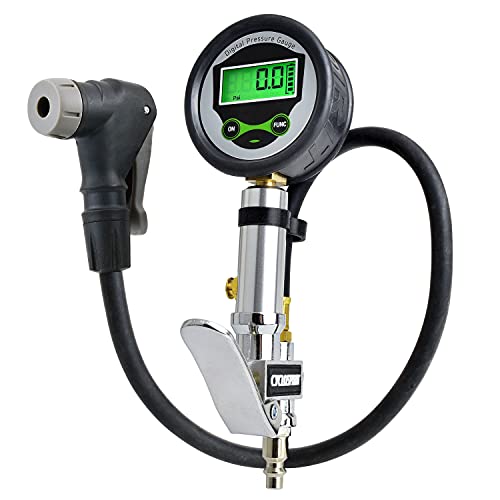
The Universal Digital Tire Inflator is an essential tool for anyone who owns a bike or a car. With its smart inflator head, it fits both Presta and Schrader valves automatically, eliminating the need for valve adapters. This makes it a versatile tool that can be used on a variety of tires.
The built-in pressure gauge is accurate and easy to read with a range of 0-200 psi (0-13.5atm). This makes it ideal for MTB and Road Tires with Tubes or Tubeless of any size and any pressure requirements, as well as cars. The gauge has an auto on-off feature and comes with batteries included for convenience.
The CycloSpirit Tire Inflator also features an integrated pressure relief button, protected gauge, and an 18" rubber hose. Designed for home mechanics as well as for bicycle shops, this tool is built to last and ready to handle any job.
The 1/4" NTP quick connect coupler is mounted in the USA, so you can be sure of its quality. The CycloSpirit Tire Inflator is ready to use as soon as you take it out of the box, making it a hassle-free addition to your toolkit.
With its fine-tuned pressure lever, you can inflate as slow as you need for tubes or as fast as you need when mounting tubeless tires with or without Presta Valve Core mounted. This feature ensures that you can inflate your tires at the perfect speed, without any risk of damage.
7. Astroai Digital Tire Gauge With Backlight And Grip.
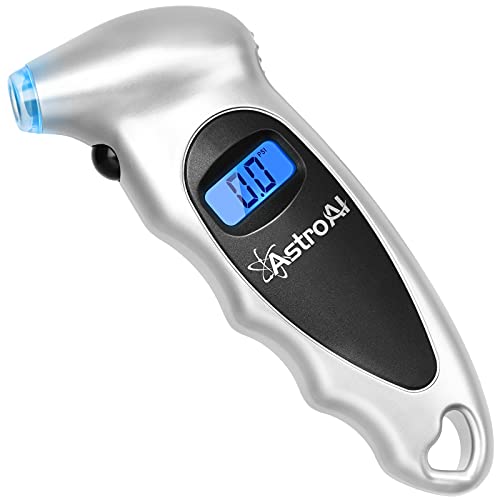
Introducing the AstroAI tire gauge, the perfect tool for maintaining correct tire pressure and extending the life of your vehicle's tires. With a backlit LCD display and lighted nozzle, this gauge is perfect for use in dimly lit areas.
No longer do you have to guess the pressure of your tires with analog gauges. The digital display of the AstroAI tire gauge shows readings instantly and clearly. The nozzle easily forms a seal with the valve stem on schrader valves, giving quick and accurate readings in 0.1 increments. The gauge has four settings with a range of 0-150PSI / 0-10Bar / 0-10Kgf/cm² or 0-1000KPA, making it suitable for use with a wide range of vehicles such as cars, trucks, and motorcycles.
Using the AstroAI tire gauge is simple. Just press the "ON/UNIT/OFF" button to turn on the tool, select the range, and it will automatically shut off in 30-40 seconds to save power. The non-slip texture makes it easy to hold onto, and the ergonomic design is suitable for both men's and women's hands. The gauge automatically resets when taking pressure, eliminating the need to calibrate or reset the device.
The AstroAI tire gauge comes with a battery included, making it a perfect gift for car enthusiasts. It is versatile, making it suitable for use with cars, trucks, motorcycles, bicycles, and more. However, it is not compatible with presta stems.
8. Godeson Presta Tire Pressure Gauge, Presta Valve Tire Pressure Gauge
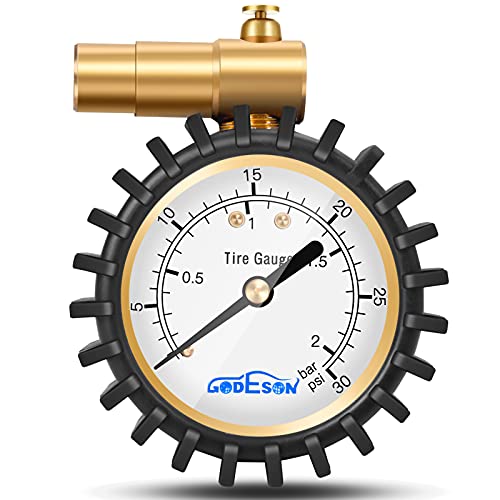
Introducing the Legible 2.0’’ Dial with Special Chuck for Presta Tire Valves Only Pressure Gauge, the perfect tool for road cycling enthusiasts who want to keep their tires at the ideal pressure. This pressure gauge is specifically designed for Presta valves and cannot be used for Schrader valves.
Equipped with a reliable Bourden tube mechanism, this pressure gauge performs exceptionally well in different temperature, altitude, or humidity conditions, without the need for batteries. The pressure range of this bike Presta tire pressure gauge is from 0 to 160psi/ 0 to 11bar, with a dual scale that offers English and Metric readings, making it easy to operate for people of different backgrounds.
The Air Bleeder Button feature allows the pressure gauge to hold the pressure, making it easy to read the pressure value. If the gauge fails to hold the readings, simply rotate the button to dislodge any small particles that may have gotten stuck, causing air leaks.
The pressure gauge is covered with a Gear Style Rubber that provides durable protection against drops and knocks. The rubber also provides a good touch feeling, allowing for a comfortable grip. It is important to avoid violent shocks to the pressure gauge to prevent damage.
In the rare case that you experience any inaccuracies with the readings, feel free to contact the manufacturer for a solution. Overall, the Legible 2.0’’ Dial with Special Chuck for Presta Tire Valves Only Pressure Gauge is an excellent tool for road cycling enthusiasts who want to keep their tires at the ideal pressure, ensuring a smooth and safe ride.
9. Godeson Presta Valve Bicycletire Pressure Gauge 0-160psi And 0-11bar
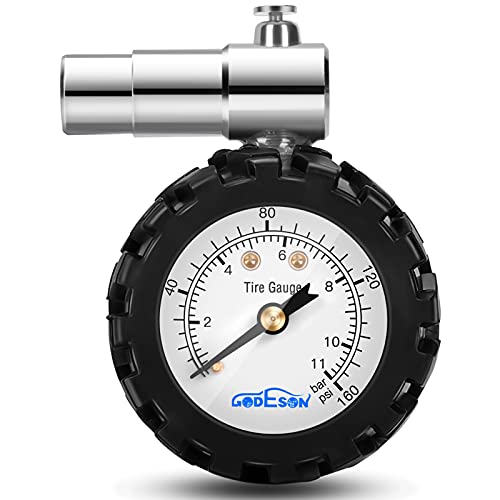
Looking for a reliable and accurate bike tire pressure gauge that doesn't require batteries? Look no further than this mechanical gauge. With a Bourden tube mechanism, this gauge will maintain its accuracy and performance for years to come.
The 1.5 inch dial is easy to read and comes with a special chuck designed for Presta tire valves. To ensure accurate readings, it's important to keep the gauge chuck angle consistent with the valve stem and make sure the chuck clamps onto the valve stem tightly.
This gauge has a pressure range of 0 to 160psi/0 to 11bar and features a dual scale with both English and Metric units, making it easy for riders of all backgrounds to use.
The mini size of this gauge makes it easy to carry in a handlebar pack or seat pack, so you can always have it on hand when you need it. And, thanks to the excellent air valve button, you can easily make tire deflation adjustments or reset the dial as needed.
This gauge makes for a great Christmas gift for both men and women who take their biking seriously and want to ensure their tires are always properly inflated. Don't settle for a subpar gauge – choose this reliable mechanical bike tire pressure gauge for all your biking needs.
10. Accu-Gage Fat Bike Presta Valve Low Pressure Bicycle Tire Gauge, 15psi
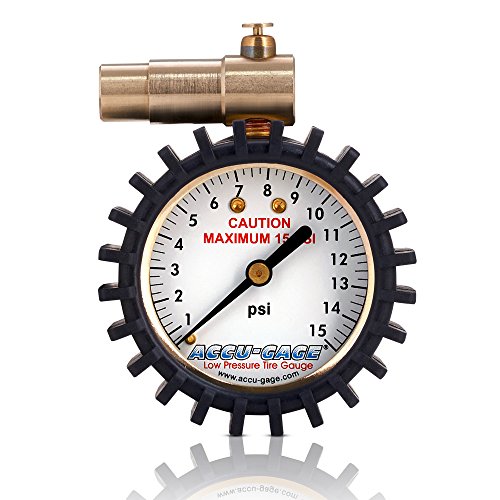
If you're a cyclist who rides a fat bike with Presta valves, the Accu-Gage Fat Bike Pressure Gauge might be the tool you need to keep your tires properly inflated. This gauge is specially designed for fat bikes with 5" tires, where small variations in pressure can significantly affect ride quality and traction. Please note that this gauge is not compatible with Schrader valves that are commonly found on cars and ATVs.
Unlike digital gauges that can be affected by temperature, altitude, or humidity, the Accu-Gage Fat Bike Pressure Gauge features a Bronze Bourdon tube precision movement that is not impacted by these factors. Additionally, you won't need to worry about batteries since this gauge doesn't require them.
The accuracy of the Accu-Gage Fat Bike Pressure Gauge conforms to ANSI B40.1 Grade B and California regulation standards, ensuring that you get precise readings every time. The gauge also features a pressure-holding function that maintains the reading until it is released. Moreover, a bleeder button is included to release the pressure reading and bleed air from the tire if necessary.
The Accu-Gage Fat Bike Pressure Gauge is backed by a lifetime warranty in the USA and Canada, so you can purchase with confidence. Whether you're a serious cyclist or a weekend rider, this pressure gauge is a valuable tool that can help you maintain your bike's performance and keep your ride safe and enjoyable. Don't hesitate to add it to your cart today!
Best Tire Pressure For Mountain Bike FAQs
Can using a tire pressure gauge help improve your mountain biking experience?
Yes, using a tire pressure gauge can definitely help improve your mountain biking experience. Proper tire pressure is crucial for any type of biking, but it becomes even more important when you’re riding on uneven and unpredictable terrain. If your tire pressure is too low, you risk damaging your rims and tires on rocks, roots, and other obstacles. On the other hand, if your tire pressure is too high, you’ll have less traction and control, making it harder to navigate technical sections of the trail.
By using a tire pressure gauge, you can ensure that your tires are inflated to the appropriate level for your weight and riding style. This will give you better control and stability on the trail, as well as a smoother ride. It will also help prolong the life of your tires and prevent unnecessary flats.
In short, using a tire pressure gauge is a simple and effective way to optimize your mountain biking experience and make the most of your time on the trails.
Does tire pressure vary based on rider weight and riding style?
Yes, tire pressure can vary based on rider weight and riding style. The recommended tire pressure listed on the sidewall of the tire is a general guideline, but it may not be suitable for all riders. Heavier riders will require higher tire pressure to support their weight and prevent excessive tire wear. Similarly, aggressive riders who frequently corner and brake hard may benefit from higher tire pressure to maintain stability and prevent the tire from squirming or rolling over. Conversely, lighter riders may need lower tire pressure to ensure proper traction and handling. It's important to note that tire pressure should always be checked and adjusted regularly to ensure optimal performance and safety. Riders should consult their bike manufacturer's recommendations and consider their own weight and riding style when determining the appropriate tire pressure for their bike.
How can tire pressure impact the durability of your mountain bike tires?
Tire pressure is a crucial factor in determining the durability of your mountain bike tires. If the tire pressure is too low, the tire will deform under the weight of the rider and the bike, causing the tire to wear out quickly. The tire will also be more susceptible to pinch flats, where the tube is pinched between the tire and the rim, causing a puncture.
On the other hand, if the tire pressure is too high, the tire will be more prone to punctures and will have less traction on the trail. It may also cause the tire to bounce on rough terrain, leading to a loss of control and potential damage to the bike.
It is important to check the tire pressure before every ride and adjust it according to the terrain and riding conditions. A good rule of thumb is to have a slightly lower tire pressure for rough and rocky trails and a slightly higher pressure for smooth and fast trails.
Maintaining the correct tire pressure will not only increase the durability of your mountain bike tires but also improve your riding experience, providing better traction, control, and comfort on the trail.
How do you determine the ideal tire pressure for your mountain bike?
Determining the ideal tire pressure for your mountain bike is crucial in order to achieve optimal performance, comfort, and safety while riding. There are various factors that can affect the ideal tire pressure such as rider weight, terrain, and tire size.
The best way to determine the ideal tire pressure is by checking the recommended range that is usually indicated on the sidewall of the tire. This range can vary depending on the manufacturer and model of the tire, so it’s important to check it before every ride.
Another way to determine the ideal tire pressure is by doing a “squeeze test”. This involves squeezing the tire with your fingers and adjusting the pressure until it feels firm but still has some give.
It’s also important to take into consideration the terrain you will be riding on. For example, if you’re riding on rough terrain, you may want to lower the tire pressure a bit to increase traction and absorb shock. On the other hand, if you’re riding on smoother terrain, you may want to increase the tire pressure for better efficiency.
Overall, determining the ideal tire pressure for your mountain bike may require some trial and error, but paying attention to these factors can help you achieve the best performance and comfort while riding.
How does tire pressure affect the performance of a mountain bike?
Tire pressure is an essential factor that affects the overall performance of a mountain bike. The amount of air pressure in your tires can significantly impact the way your bike rides on different terrains.
If you ride with low tire pressure, your bike's handling and stability will be compromised. Low tire pressure can make your bike feel sluggish and unresponsive, and it can also increase the risk of pinch flats and damage to the rims. On the other hand, overinflated tires can lead to a harsh ride and reduce traction on rough terrains.
The ideal tire pressure for your mountain bike depends on several factors, such as your weight, riding style, and the type of terrain you're riding on. Generally, a higher tire pressure is recommended for smoother surfaces like roads, while lower tire pressure is better for rougher terrains like singletrack or rocky trails.
It's essential to check your tire pressure regularly and adjust it according to the terrain you'll be riding on. Having the proper tire pressure can improve your mountain bike's performance, making it more efficient, comfortable, and enjoyable to ride.
How often should you check and adjust your mountain bike tire pressure?
Checking and adjusting your mountain bike tire pressure is crucial to ensure optimal performance and safety. The frequency of checking and adjusting your tire pressure depends on various factors such as the type of terrain you ride on, weather conditions, and your personal preference.
As a general rule, it is recommended to check your tire pressure before every ride. This ensures that your tires are at the correct pressure and are ready to handle the demands of the terrain. However, if you ride less frequently, checking your tire pressure once a week is sufficient.
Adjusting your tire pressure is also important, especially if you are riding on different terrains. For instance, if you are riding on rocky or technical terrain, you may want to lower your tire pressure to enhance traction and improve your bike's stability. On the other hand, if you are riding on smooth or hard-packed trails, you may want to increase your tire pressure for better rolling resistance and efficiency.
In summary, checking and adjusting your mountain bike tire pressure is a critical aspect of bike maintenance. It is recommended to check your tire pressure before every ride and adjust it based on the terrain you plan to ride on.
What are the benefits of finding the right tire pressure for your mountain bike?
Finding the right tire pressure for your mountain bike can provide numerous benefits. Firstly, it can significantly improve your bike's performance on the trail. The correct tire pressure ensures that your tires maintain optimal grip on the terrain, improving handling and stability. This, in turn, can increase your speed and make your ride more efficient.
Additionally, the right tire pressure can enhance your bike's durability and longevity. Over-inflated tires can result in increased wear and tear on the tire, while under-inflated tires can cause pinch flats and damage to the rims. By maintaining the correct tire pressure, you can reduce the risk of damage to your bike and prolong its lifespan.
Another benefit of finding the right tire pressure is increased safety on the trail. Properly inflated tires provide better traction and can reduce the risk of accidents and injuries. This is especially important when riding in challenging terrain or adverse weather conditions.
Overall, finding the right tire pressure for your mountain bike is essential for optimal performance, durability, and safety on the trail. It is recommended to check your tire pressure before every ride and adjust accordingly to ensure the best possible riding experience.
What are the consequences of overinflated or underinflated mountain bike tires?
Mountain biking is an adventurous and thrilling outdoor activity, but it requires proper equipment maintenance to ensure a safe and enjoyable ride. One of the critical components of a mountain bike is its tires, and underinflated or overinflated tires can lead to various consequences.
Overinflated tires can cause a harsh ride, and the bike may bounce around, leading to a loss of control and stability. It may also result in reduced traction, and the tires may easily slide or skid on loose terrain. Additionally, overinflated tires are prone to punctures and may burst when subjected to sharp objects or rough terrain.
On the other hand, underinflated tires can cause a sluggish ride, making it challenging to pedal and maneuver the bike. The tires may also bottom out on rough terrain, causing damage to the wheels and rims. Moreover, underinflated tires are prone to pinch flats, and the rider may experience more punctures, leading to frequent repairs and replacements.
Therefore, it is crucial to maintain the right tire pressure and regularly check the tire pressure using a pressure gauge. The recommended tire pressure varies depending on the tire type, rider weight, and terrain. By ensuring proper tire pressure, the rider can enjoy a comfortable, safe, and efficient ride.
What is the best tire pressure for mountain biking on different terrains?
The best tire pressure for mountain biking on different terrains depends on various factors such as rider weight, tire size, trail conditions, and personal preferences. Generally, a lower tire pressure is preferred for loose and rough terrains such as mud, sand, and gravel. This is because a lower pressure allows the tire to conform to the terrain and provide better traction and control. On the other hand, a higher tire pressure is suitable for smoother terrains such as hard pack and asphalt. This is because a higher pressure decreases rolling resistance and increases speed.
It is recommended to start with a pressure range of 25-35 psi and adjust accordingly based on the aforementioned factors. It is also essential to check tire pressure before every ride to ensure optimal performance and prevent damage to the tire. Ultimately, finding the perfect tire pressure is a matter of trial and error, and riders should experiment with different pressures to find what works best for them and their specific riding style.
What is the recommended tire pressure for tubeless mountain bike tires?
The recommended tire pressure for tubeless mountain bike tires can vary depending on the specific tire and rider preference. However, as a general rule of thumb, most manufacturers suggest running tubeless tires at a lower pressure than traditional tubed tires. This is because tubeless tires allow for better traction and a more comfortable ride due to their ability to conform to the terrain.
A good starting point for tubeless mountain bike tire pressure is around 20-25 psi for trail riding and 25-30 psi for cross country riding. However, it's important to note that the ideal tire pressure can vary based on the rider's weight, riding style, and the trail conditions.
To determine the ideal tire pressure for your tubeless mountain bike tires, it's recommended to start with a lower pressure and gradually increase it until you find the sweet spot that provides the right balance of traction, stability, and speed. It's also important to regularly check your tire pressure and adjust it as needed to ensure optimal performance and safety on the trails.







